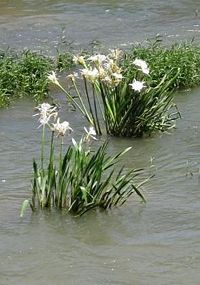Cahaba lily
The Cahaba lily (Hymenocallis coronaria) is a type of spider lily native to sunny, fast-flowing shoals in the Cahaba, Black Warrior, Coosa, Tallapoosa and Chattahoochie River systems in Alabama and to a few rivers in Georgia and South Carolina. There are currently 70 documented populations of the plant, of which 46 are in Alabama, including a large stand protected within the Cahaba River National Wildlife Refuge near West Blocton.
The aromatic flower, which appears from mid-May to mid-June, is white, crown-shaped and approximately 3 inches in diameter. New blooms appear daily and are pollinated by Plebeian sphinx moths and Pipevine swallowtails. Once germinated, new seeds drop into the water where they form bulbs and lodge between rocks, ready to send up leaves and flowering shoots the next April.
Because the Cahaba lily's habitat is restricted to shallow, free-flowing shoals it has been threatened by the damming of large rivers for hydroelectric power as well as by silt and deposits from mining, industry and construction.
In May 2024 Grizzly Creek Films of Bozeman, Montana spent a week filming the stand at the National Wildlife Refuge day and night in hopes of capturing the plants' pollination for an upcoming PBS documentary.
References
- Davenport, Lawrence J. (October 1996) "The Cahaba Lily: Its Distribution and Status in Alabama." Journal of the Alabama Academy of Sciences. No. 67, pp. 222–233
- Davenport, Lawrence J. (January 30, 2007) "Cahaba Lily" Encyclopedia of Alabama - accessed July 10, 2007
- Velasco, Anna (June 1, 2008) "A Cahaba lily by any other name would smell so sweet." The Birmingham News
- Garrison, Greg (May 21, 2024) "PBS crew works to capture Alabama’s Cahaba lilies on film, in moonlight with moths." AL.com
